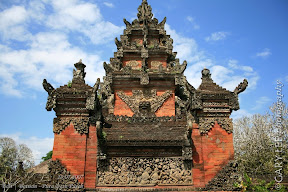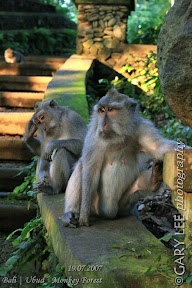 Ubud, sometimes known as the real Bali, which is in contrast with Kuta. The people of Ubud are known for their paint, carve, dance and music, and strict religious practices.
Ubud, sometimes known as the real Bali, which is in contrast with Kuta. The people of Ubud are known for their paint, carve, dance and music, and strict religious practices.
In Batubulan, it’s more of a public-transport interchange for bemos. However, it is the home for the famous Barong troupes and is respected across the whole island for its stonecarvers.
 The Barong-Rangda dance represents the conflict between the good and evil. And again, is one of the symbolic episodes in the Mahabhrata story. Rangda(queen of witches) is often called as a character that causes harm, evil and destruction while the Barong is always the defender of the good. The image of Rangda can be seen everywhere in Bali, especially in temples. She has a long hair with flames coming out from her head. Her face is hideous with bulging eyes, a gaping mouth, huge teeth and a long tongue that touches her knees. Her fingernails are long and curled and she has an enormous breast. The Barong shows a more lovable figure, a shaggy-haired creature like a horse and a Chinese dragon. There are a few Barongs such as Barong Ket (lion), Barong Macan (tiger), Barong Bangkal (wild boar) and Barong Celeng (pig).
The Barong-Rangda dance represents the conflict between the good and evil. And again, is one of the symbolic episodes in the Mahabhrata story. Rangda(queen of witches) is often called as a character that causes harm, evil and destruction while the Barong is always the defender of the good. The image of Rangda can be seen everywhere in Bali, especially in temples. She has a long hair with flames coming out from her head. Her face is hideous with bulging eyes, a gaping mouth, huge teeth and a long tongue that touches her knees. Her fingernails are long and curled and she has an enormous breast. The Barong shows a more lovable figure, a shaggy-haired creature like a horse and a Chinese dragon. There are a few Barongs such as Barong Ket (lion), Barong Macan (tiger), Barong Bangkal (wild boar) and Barong Celeng (pig). Next to Batubulan is Celuk, known as the silver village because it’s a major center for jewellery production. Nearly the whole stretch of houses and shops here sells silver, gold and other jewelleries.
Next to Batubulan is Celuk, known as the silver village because it’s a major center for jewellery production. Nearly the whole stretch of houses and shops here sells silver, gold and other jewelleries.
The main temple, Pura Desa Puseh, in the north of the village is heavily decorated. It has a five-tiered gateway tower inspired by Indian religious architecture. In this temple, there are some Buddha images, which differs from the other Balinese temple.
There are basically 3 main roads north of UBUD that leads to the Gunung Batur. Upon heading up to the crater rims of Gunung Batur, rice paddies can be seen from above. The terraces are carved from the hillsides of the island.


It has been roughly 20 years since Gunung Batur erupted. It is scary to see the volcano still smoking, but the locals do belief that its better if Batur lets off a little steam regularly rather than saving it all up for a major blow. The view from Penelokan, which means, “place to look” is amazing. Tourists pass through Penelokan everyday, attracting locals selling all sorts of stuffs. It’s really a pain as they will follow and keep pestering you to buy and even offering the cheapest price. This crater rim is also packed with restaurants offering expensive buffet lunches. But it might be worth it – think of having lunch while enjoying the cool breeze and the amazing view of the volcano. It is said that the water surrounding the volcano is suppose to be holy as well. On the way down, there’s a small coffee plantation along the road. Tourist will go through the plantation with trees labeled before actually arriving at the shop. Resting huts are prepared on the hillsides for tourist to enjoy a cup of 6 different kinds of drinks. It is a relaxation to be able to drink and enjoy the scenery of greens there.
On the way down, there’s a small coffee plantation along the road. Tourist will go through the plantation with trees labeled before actually arriving at the shop. Resting huts are prepared on the hillsides for tourist to enjoy a cup of 6 different kinds of drinks. It is a relaxation to be able to drink and enjoy the scenery of greens there. Balinese from every corner of the island make pilgrimages to Tirta Empul, which is somewhere in Kintamani. They locals come here to cleanse themselves and to cure their physical ailments by bathing in the holy springs here. Legend says that the god Indra first tapped the springs during his battle with the evil Mayadanawa, early ruler of the Pejeng kingdom. Mayadanawa then poison the rivers, so Indra pierced the earth to release a spring of pure and sacred water – the elixir of immortality. Hence this new spring is called as Tirta Empul and has been the holiest in Bali. The bathing pools are sunk in the ground of the outer courtyard, fed by water from the springs in the inner sanctuary. Men, women and priests each have their own section of the pool.
Balinese from every corner of the island make pilgrimages to Tirta Empul, which is somewhere in Kintamani. They locals come here to cleanse themselves and to cure their physical ailments by bathing in the holy springs here. Legend says that the god Indra first tapped the springs during his battle with the evil Mayadanawa, early ruler of the Pejeng kingdom. Mayadanawa then poison the rivers, so Indra pierced the earth to release a spring of pure and sacred water – the elixir of immortality. Hence this new spring is called as Tirta Empul and has been the holiest in Bali. The bathing pools are sunk in the ground of the outer courtyard, fed by water from the springs in the inner sanctuary. Men, women and priests each have their own section of the pool. The Sacred Monkey Forest Santuary is located in Ubud. Balinese treat monkeys with great respect and is important to the Balinese culture. Therefore, this forest is for the home of these monkeys. This is considered as a holy area and an important ecological preserve. There are 3 holy temples in this forest, the Pura Dalem Agung Temple, the Holy Bathing Temple which a structure of “Three Mandalas” and the Pura Prajapati (the funeral or cremation temple).
The Sacred Monkey Forest Santuary is located in Ubud. Balinese treat monkeys with great respect and is important to the Balinese culture. Therefore, this forest is for the home of these monkeys. This is considered as a holy area and an important ecological preserve. There are 3 holy temples in this forest, the Pura Dalem Agung Temple, the Holy Bathing Temple which a structure of “Three Mandalas” and the Pura Prajapati (the funeral or cremation temple).
CLICK HERE FOR MORE PICS
Wednesday, 8 August 2007
Bali Trip - 3rd Day (19.07.2007)
Related Topics:
Travel
at
12:59
![]()
Subscribe to:
Post Comments (Atom)
No comments:
Post a Comment